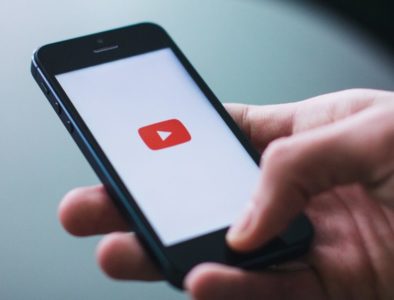Perhaps one of the hardest things to do with video content–but the single most important thing–is to capture your viewer’s attention and hold it. For a standard YouTube upload, you have about 10-20 seconds to “hook” your viewer. For short-form video platforms like TikTok, you have roughly 3 seconds! That may seem remarkably fast, but it only takes the human brain 13 milliseconds to process what it’s seeing and then decide whether to stay or go.
When you really nail your intro, the audience retention curve (the number of viewers watching over time) will look like a shallow “S” shape. You’ll always lose some of your audience in the intro and then there’s a shallow drop-off over the length of the video, followed by a steep drop-off at the end as you wrap up and introduce a call-to-action.

When the intro doesn’t hit, the curve will look like a deep “L”. You lose most of the viewers in the first 20 seconds and by the end of the video, barely anyone is watching. Womp womp…

The algorithms that determine which video to show viewers next really don’t like the second scenario. This is because platforms like YouTube want more people to watch the entire video so that they can serve them more ads along the way. At its core, YouTube (and Google for that matter) is an advertising company that supports its massive and ever-growing video library with ad dollars.
So what can be done to avoid the deep “L”? The key is to “hook” the viewer in those first precious seconds, and below are what I believe are the four key elements to creating a compelling hook:
- Stimulation – Does the intro provide visual and/or auditory stimulation and excitement?
- Curiosity – Does the intro create a need to know the answer or outcome?
- Emotion – Does the intro provoke an emotional response, either positive or negative?
- Relevance – Does the intro feel personally relevant to the viewer?
Based on these four elements, let’s look at some effective intros that make use of one or more of them:
Shock and Awe (Stimulation)
Visually-compelling imagery like drone shots, dramatic landscapes, extreme close-ups, daring action, beautiful people, etc. All of these capture your audience’s attention purely based on the fact that they create a visual and auditory spectacle that stimulates the senses.
Example: Yes Theory
Yes Theory is a travel channel that journeys to unusual places. In this episode, they visited an abandoned development in a remote region of Turkey where every house was supposed to look like a miniature Disney castle. The video opens with stunning aerial shots from various abandoned sites around the world, a common tactic on this channel.
Show a Process (Curiosity)
Particularly for short-form video, showing a process seems to be an effective hook–whether you’re showing the process of making food or fixing a roof, it’s curiosity that drives viewers to watch until the end. It’s so effective, that sometimes I have to remind myself that I don’t really need to know how to fix a roof (I’m a renter!) and that I have better things to do with my time. For longer processes, timelapse and tight editing can help engage the viewer.
Example: 5-Minute Crafts
5-Minute Crafts is a popular YouTube channel devoted to showing the process for making cute crafts at home. This type of video is so popular that the channel boasts over 80 million subscribers! In this video, they show how to make some little gadgets out of leftover cardboard. I seriously question if anyone actually makes this stuff or if they just enjoy watching the process!
Start in the Middle (Curiosity, Stimulation)
One of my favorite storytelling devices is called “In Media Res” which translates to Latin as “In the Middle, Begin.” Basically, you start the story in the middle at the most dramatic point and then backtrack to show how you got there. You will often see process videos (above) use this technique by teasing the end result at the very beginning. This makes people extremely curious to see how the creator got from A to Z.
Example: Me for Scientific American
I was having trouble thinking of specific YouTube videos that use this technique, so I’m going to reference my own production for Scientific American in which I made a deliberate use of In Media Res. I went on location to film a chef who specializes in cooking invasive species off Connecticut’s Gold Coast. We open with our host, Scientific American editor Michael Moyer, dropping backwards off of a boat into Long Island Sound and then revealed how he ended up in this situation.
Ask a Question (Curiosity, Relevance)
A really simple way to hook viewers is to ask a question. I often see public speakers use this strategy as well. Obviously, this is a basic way to peak your audience’s curiosity, especially if the question is directly relevant (see: pain points below).
Example: Mark Rober
Engineering YouTuber Mark Rober is probably best known for his videos featuring elaborate pranks on porch pirates and gravity-defying obstacle courses for squirrels, but one thing you’ll notice is that nearly all of his videos start with a question. In the example below the question is “Which is more destructive,…lava or lasers?” These are questions the world needs answers to!
Speak to Pain Points (Relevance, Emotion)
For marketing or solution-oriented videos, opening with your audience’s “pain points” is an effective strategy to communicate relevance. While it may sound kind of manipulative, your audience or customer’s pain points are the problems they are trying to solve and often have a feeling of frustration about. They’ll be grateful if you can legitimately help solve them.
Example: Codie Sanchez
Codie Sanchez is an entrepreneur and rising star on YouTube. In the video below, she opens with some alarming statistics about the failure rate of new businesses and speaks to the common fears of would-be entrepreneurs. Her video offers solutions to these fears as she talks about businesses with the highest likelihood of failure and those with the greatest chance of success.
Tell a Story (Emotion, Curiosity)
The human brain is wired for stories. It’s why in this digital age awash with information we still rely on stories to help us make sense of it all. And good stories are loaded with emotion, both positive and negative: grief, disappointment, triumph, glee, etc. Jokes are mini-stories too. They have a setup, a punchline, and a resolution.
Example: TED Talks
If you look at the structure of most TED Talks the speaker opens with a personal anecdote. The anecdote is designed to send viewers on an emotional rollercoaster ride, often punctuated by humor. The most popular TED talk of all time is “Wait But Why” blogger Tim Urban’s journey through chronic procrastination. Tim is an animated speaker and his story immediately draws you into his world.
Go Somewhere (Curiosity, Stimulation)
The walking, talking to-camera intro has become ubiquitous on YouTube for a good reason. Moving through your environment accomplishes two things: it creates motion that stimulates the senses while simultaneously creating curiosity about where you’re going.
Example: Casey Neistat
Perhaps the king of this type of video is popular YouTuber Casey Neistat. His videos often open with him on the move through the streets of NYC. It’s captivating because you immediately wonder about his destination. In this recent example, Casey is taking a taxi, but he’s often braving his way through traffic on his e-powered skateboard which is kind of thrilling to watch.
Animation & Motion Graphics (Stimulation)
Some of my most successful videos are animated. Animation done well is visually compelling and the bright colors and simple shapes speak to our inner child. In 2024, there are many different kinds of animation to choose from, but I’m partial to 2D cartoon-style animation that harkens back to the Chuck Jones and Hanna-Barbera era.
Example: Me for Scientific American
In the example below, we took a very serious and potentially macabre topic–what happens to your corpse after you die–and poked fun at it with a South Park-style animation (“You killed Kenny, you bastards!”) The results speak for themselves….12 million views and many copycat videos on the same topic.
Reference a Famous Person (Relevance)
Even though most people don’t personally know famous celebrities, we often feel like we do. The instant recognition and familiarity of A-List actors is why they’re paid the big bucks for appearing in films and endorsing products. So if you want to make your video instantly relevant to people, start it off with someone famous.
Example: Charisma On Command
Charisma on Command is a channel devoted to helping people develop their personal charm and charisma. They often hook viewers by referencing a celebrity and analyzing their behavior for clues on why they’re loved or hated. In this example, they focus on Keanu Reeve’s endearing attitude, even featuring him prominently in the thumbnail image.
Final Thoughts
If you look at big-budget Hollywood films with compelling intros, they often employ some or all of the elements we’ve outlined in their opening sequences. Start with Stimulation in the form of stunning visuals, build Curiosity by slowly revealing story details, tweak Emotion to get them invested, and cast celebrities with the right demographics to establish immediate Relevance to the target audience.
An example that hits all of these notes is the title sequence for Back to The Future directed by Steven Spielberg. The first four minutes immediately pull you into the story through a combination of Stimulation (panning camera movement over interesting objects), Curiosity (Who made all these gadgets?), Emotion (visual humor) and Relevance (there was no bigger teen star than Michael J. Fox in the mid-1980s). It should be noted, however, that feature-length movies have much longer to capture attention than your typical social media video, so don’t spend four minutes on your hook.


